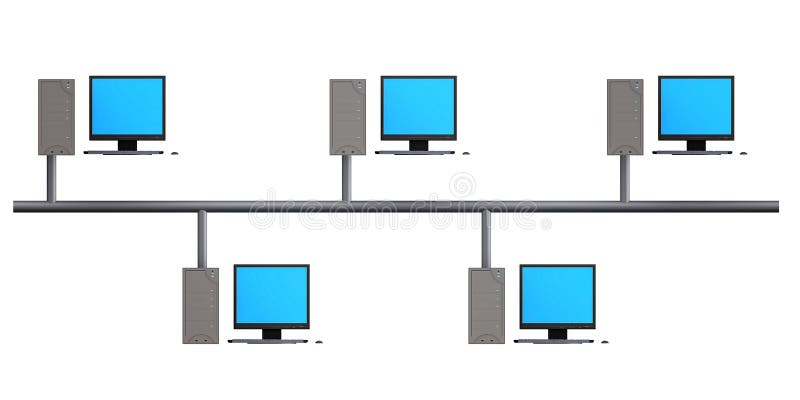TOPOLOGY
- It referes in 2 types as physical or logical arrangment of network
* Types of topologies in physical
1. Single node
2. Bus
3. Star
4. Ring
5. Mesh
6. Tree
7. Hybrid
* Devices operates on files from server & returns them back after completing the task
ADVANTAGE :-
1. Easy to install configure & manage
2. Least expensive
3. Single cable is requried
DISADVANTAGE :-
1. Network consists of single device
2. Dumb terminal is depend on server
* Types of topologies in physical
1. Single node
2. Bus
3. Star
4. Ring
5. Mesh
6. Tree
7. Hybrid
1. Single node Topology :-
* single device , at times device called dumb terminal is connected to the server* Devices operates on files from server & returns them back after completing the task
ADVANTAGE :-
1. Easy to install configure & manage
2. Least expensive
3. Single cable is requried
DISADVANTAGE :-
1. Network consists of single device
2. Dumb terminal is depend on server
 |
2. Bus topology :-
* All devices are connected to common cable called trunk
* Maximum segment length of cable is (200 m)
* Maximum 30 devices per segment
* Terminal are used to transfer data within the trunk terminal
* when 2 singnal colides collision occures
* 50 OHM terminator is used
* Server is at one end and devices are at different positions.
* It operates at half duplex
ADVANTAGE :-
1. Installing device is easy
2. Requries less cables compare to star topology
3. Less expensive & works better for smaller network.
DISADVANTAGE :-
1. If back bonebreaks entire networks gets down.
2. Difficult to isolate problems
3. Limited number of devices.
 3. Star topology:-
* Each devices is connected to centrilized network
* Data passes through centrilized network before destination
* Star topology with switch doesn't broadcast data it will transfer data to specific destination
* Multiple device can transmit or recive data at a time.
* It operates at full duplex
ADVANTAGE :-
1. Easy to configure , manage , install , expand
2. Centralized managment
3. Addition or removal of device dose not effect the whole network
DISADVANTAGE:-
1. Requries more cable
2. Failure of hub effects entire network
3. More expensive
 4. Ring topology :-
* Devices are connected in closed loop
* All devices have equal access to media
* Device waits for its turn to transmit
* Most common type of token ring
ADVANTAGE :-
1. Data travels at great speed.
2. No collisions
3. Handels large volume of traffic
DISADVANTAGE :-
1. More cabling is requried as compared to BUS
2. One faulty device effect the entire network
3. Addition of devices effect network
 5. Dual Ring topology :-
* Consist of two independent primiry and secondary rings
* Secondary ring is redundant , used only when primary stops functioning
 5. Mesh topology :-
* Used in WANs to inter connect LANs
* Every device is connected to every other device
* Use routers to determine the best path of communication
ADVANTAGE :- 1. Improves fault tolerance 2. Failure of one link does not effect entire network 3. centrilized managment is not required DISADVANTAGE :- 1. Difficult to install & manage 2. Each link from one device to other requires individual NIC 3. Very much expensive
THERE ARE TWO TYPE OF MESH
1. Full mesh = All devices are connected to each other
2. Partial mesh =Some devices are connected to only those with whom they exchange most of the data
6. Tree topology :-
* Connects group of star network
* Device are wired to root hub
* Root hub is connect to second level devices
* Lowest level devices are smaller computers
ADVANTAGES :- 1. Easy to add new devices 2. Point to point wiring for each devices 3. Fault detection is easy DISADVANTAGES :- 1. Difficult to configure 2. If backbone breaks entire network gose down 3. More expensive 7. Hybrid topology :-
* Combines two or more different physical topology
* Commonly star-bus or star-ring
* Star-ring uses Multistation access unit (MAU)
ADVANTAGE :-
1. Used for creating large networks
2. Handels large volume of traffic
3. Fault detection is easy
DISADVANTAGE :-
1. Installation and configuration is difficult
2. More expensive then other topology
3. More cabling is required
|

Comments
Post a Comment